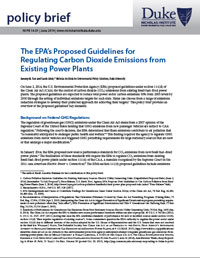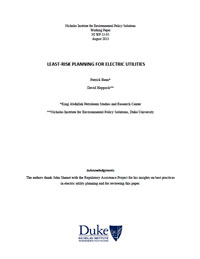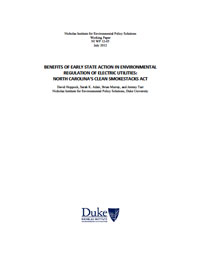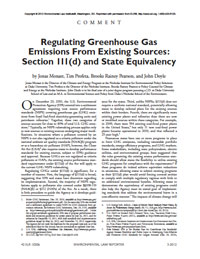Publications
The EPA’s Proposed Guidelines for Regulating Carbon Dioxide Emissions from Existing Power Plants
On June 2, 2014, the U.S. Environmental Protection Agency proposed guidelines under section 111(d) of the Clean Air Act for the control of carbon dioxide emissions from existing fossil fuel–fired power plants. The proposed guidelines are expected to reduce total power sector carbon emissions 30% from 2005 levels by 2030 through the setting of individual emissions targets for each state. States can choose from a range of emissions reduction strategies to develop their preferred approach for achieving their targets. This policy brief provides an overview of the proposed guidelines’ key elements.
Beyond Carbon Dioxide: Capturing Air Quality Benefits with State 111(d) Plans
With finalization of the EPA’s section 111(d) guidelines, states will make decisions about how to reduce carbon dioxide emissions. These decisions could fundamentally affect the U.S. power sector and will be made in an environment of uncertainty about the timing, stringency, and compliance costs of future air quality regulations. In light of this uncertainty, states may wish to look beyond carbon dioxide when developing section 111(d) plans. The Clean Air Act allows them the flexibility to reduce carbon emissions in a way that hedges the risk of anticipated air regulations and that potentially lowers long-term compliance costs. This paper discusses these benefits, summarizes air quality regulations that could affect the power sector in the future, and describes how states can use the flexibility afforded them by section 111(d) to manage this regulatory risk. In addition, it identifies elements of state 111(d) plans that may lead to reductions in criteria pollutants.
New Source Review and Coal Plant Efficiency Gains: How New and Forthcoming Air Regulations Affect Outcomes
Forthcoming carbon dioxide regulations for existing power plants in the United States have heightened interest in thermal efficiency gains for coal-fired power plants. Plant modifications to improve thermal efficiency can trigger New Source Review (NSR), a Clean Air Act requirement to adopt state-of-the-art pollution controls. This article in the journal Energy Policy explores whether existing coal plants would likely face additional pollution control requirements if they undertake modifications that trigger NSR. Despite emissions controls that are or will be installed under the Mercury and Air Toxics Standards and Clean Air Interstate Rule or its replacement, 80% of coal units (76% of capacity) that are expected to remain in operation are not projected to meet the minimum NSR requirements for at least one pollutant: nitrogen oxides or sulfur dioxide. This is an important consideration for the U.S. Environmental Protection Agency and state policymakers as they determine the extent to which carbon dioxide regulation will rely on unit-by-unit thermal efficiency gains versus potential flexible compliance strategies such as averaging, trading, energy efficiency, and renewable energy. NSR would likely delay and add cost to thermal efficiency projects at a majority of coal units, including projects undertaken to comply with forthcoming carbon dioxide regulation.
Designing CO2 Performance Standards for a Transitioning Electricity Sector: A Multi-Benefits Framework
The U.S. electricity sector is in the midst of a significant transition driven by changes in markets, technology, and regulation, including a forthcoming obligation under section 111(d) of the Clean Air Act to limit carbon dioxide (CO2) emissions from existing fossil fuel-fired power plants. The broad statutory language of section 111(d) presents state regulators with an opportunity to pursue strategies that simultaneously reduce CO2 emissions and address other electricity sector needs. This report discusses challenges facing the electricity sector and the potential to implement section 111(d) compliance strategies that provide multiple benefits for the sector.
Assessing the Risk of Utility Investments in a Least-Cost-Planning Framework
Unprecedented uncertainty in the electricity sector makes it difficult to estimate the cost or likely range of costs for new capital investments. Different assumptions about the future can make an investment that is least cost in one future or scenario high cost (relative to other investments) in another. In many states, utility commissions use a least-cost framework to evaluate different investment options, but determining what is least cost is difficult and can depend on the range of potential futures that utilities and regulators consider. In this environment, critical questions for utilities and utility regulators are (1) what is the realistic range of cost estimates and (2) what risks do different options create for customers. This paper reviews metrics that utilities and utility regulators can use to evaluate investment options as well as methods to incorporate these metrics in a least-cost-planning framework.
Least-Risk Planning for Electric Utilities
In an environment of significant uncertainty about fuel prices, environmental regulations, and energy demand growth, traditional utility planning leads to investment decisions that create considerable risks, according to a report co-authored by the Nicholas Institute for Environmental Policy Solutions.
The paper describes how a minimax regret analysis could supplement current planning techniques, which typically weigh cost. By considering risk across a broad range of scenarios facing the industry, minimax regret analysis may help utilities better avoid decisions that reduce their flexibility to respond to changing market conditions. As a result, utilities can avoid regrettable investment decisions and negative effects for ratepayers while better measuring diversity in their portfolio—ensuring no one energy resource is relied on too heavily.
A Triple Bottom Line for Electric Utility Regulation: Aligning State-Level Energy, Environmental, and Consumer Protection Goals
Energy infrastructure across the United States is aging, and plant retirements are increasing due to a combination of newly implemented and impending environmental requirements and inexpensive natural gas. Utilities and regulators will have to decide how to update or replace aging facilities—estimated at a cost of $1.5 to $2 trillion over the next twenty years. This article in the Columbia Journal of Environmental Law explores the opportunities and challenges to aligning state energy, environmental, and consumer protection goals within the current regulatory system, and proposes a “triple bottom line” (“TBL”) approach to state utility regulation to achieve this alignment.
Deploying Low-Carbon Coal Technologies: The State Role in Technology Innovation
The development and deployment of low-carbon coal technologies is critical to any plan to limit greenhouse gas emissions in the United States. In 2011, coal-fired power generation contributed nearly 35% of national greenhouse gas emissions. The public sector has continued investing in research and development in recent years, and has made funds available for early demonstration projects. But even with federal funding, advanced coal demonstration projects have faced barriers at the state level, highlighting the important, but often overlooked, role that state regulators will play in deploying low-carbon coal technologies. Demonstrating and deploying low-carbon coal technologies at scale poses a number of challenges, including unique regulatory hurdles in states with traditionally regulated electricity markets. To address these challenges, this draft paper provides (1) an overview of the federal and state policies affecting deployment of low-carbon coal technologies, (2) a case study of two proposed Appalachian Power Company demonstration projects that illustrate the particular challenges in traditionally regulated states, and (3) options for both traditionally regulated and restructured states to address state-level challenges regarding technology deployment.
Benefits of Early State Action in Environmental Regulation of Electric Utilities: North Carolina’s Clean Smokestacks Act
The U.S. Environmental Protection Agency’s Cross-State Air Pollution Rule (CSAPR) and Mercury Air Toxics (MATS) Rule require power plants to install technologies that reduce sulfur dioxide, nitrogen oxide and other harmful emissions. Federal environmental regulations such as these often require compliance on restricted timelines, forcing some utilities to make significant investments over short time periods and causing sudden jumps in electricity rates for consumers. This report examines the ratepayer impacts and health benefits of North Carolina’s Clean Smokestacks Act, a law passed in 2002 requiring emission reductions similar to MATS and CSAPR. The law allowed North Carolina to stagger the cost of pollution-control technologies over a longer period and positioned the state well to comply with the EPA rules while enjoying health benefits and avoiding a sudden spike in consumer electricity rates.
Regulating Greenhouse Gas Emissions from Existing Sources: Section 111(d) and State Equivalency
On December 9, 2011, the Nicholas Institute for Environmental Policy Solutions convened a broad range of stakeholders to explore the legal and policy issues presented by the regulation of greenhouse gas (GHG) emissions under 111(d) (existing source performance standards) of the Clean Air Act. The workshop focused primarily on the options for states to demonstrate that existing GHG policies are equivalent to the 111(d) requirements. The Nicholas Institute distributed this document to workshop participants prior to the event to provide a framework for the issues that would be discussed. Nothing in this document should be interpreted as expressing the Institute’s opinion of the path the EPA should take on any given issue.










